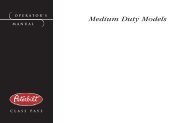MODEL 330 OPERATOR'S MANUAL - Peterbilt Motors Company
MODEL 330 OPERATOR'S MANUAL - Peterbilt Motors Company
MODEL 330 OPERATOR'S MANUAL - Peterbilt Motors Company
You also want an ePaper? Increase the reach of your titles
YUMPU automatically turns print PDFs into web optimized ePapers that Google loves.
Operating the Engine<br />
Warm–Up Procedure<br />
1. After you have started the engine, idle the engine at<br />
approximately 600 rpm while you check vital engine systems:<br />
– oil pressure<br />
– air pressure<br />
– alternator output (with the optional voltmeter)<br />
2. Before placing engine under a load, continue warm-up<br />
with the engine at 900 to 1,000 rpm for 3 to 5 minutes.<br />
• When a cold engine is started, increase the engine<br />
speed (rpm) slowly to be sure adequate lubrication<br />
is available to the bearings and to allow the oil pressure<br />
to stabilize. In extremely cold temperatures,<br />
you may have to increase idle speed.<br />
NOTE: In colder climates where the temperatures<br />
are often below freezing, sufficient warmup<br />
for turbocharged engines is especially important.<br />
Chilled external oil lines leading to the turbocharger<br />
will slow the oil flow until the oil<br />
warms, reducing oil available for the bearings.<br />
Watch the engine oil pressure gauge for a<br />
warming trend before increasing engine idle<br />
speed (rpm).<br />
Operating Instructions<br />
3. Continue the engine warm-up until the coolant temperature<br />
reaches at least 130°F (54°C). At this temperature,<br />
you can use partial throttle. Wait until the coolant temperature<br />
is at least 160°F (71°C) before operating at full<br />
throttle. See “Operating Manual Transmissions” on<br />
page 64.<br />
Idling the Engine<br />
Under most circumstances, continuous idling of your engine<br />
merely wastes fuel. In severe Arctic weather conditions, however,<br />
you may need longer idling to be sure all parts of your<br />
engine are fully lubricated.<br />
CAUTION: Do not allow your engine to idle, at<br />
low rpm (400–600 rpm), longer than five minutes.<br />
Long periods of idling after the engine has<br />
reached operating temperatures can decrease<br />
engine temperature and cause gummed piston<br />
rings, clogged injectors, and possible engine<br />
damage from lack of lubrication. The normal torsional<br />
vibrations generated can also cause<br />
transmission wear.<br />
– 60 – PB1318 3/01 Model <strong>330</strong>
















